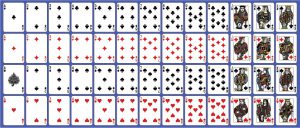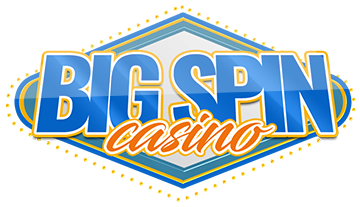Introduction to Blackjack
Blackjack is one of the most popular games played in casinos. The players play against the dealer and not other players. Because this page is for beginners, we will go over how card games are played in casinos in general before diving into the more advanced topics.
How a Traditional Deck of Cards Works In Casinos
The game of Blackjack is played using several standard decks of cards and our favorite – Litecoin Blackjack is not different. Here is what you need to know about the cards-
Each card deck has 52 cards in total, made out of 4 different suits: Diamonds, Clubs, Hearts and Spades –
In the picture below, you will immediately see there’s also a difference in coloring. The hearts and diamonds are colored red, while spades and clubs are colored black.
Each suite has 13 ranks as follows:

full card deck
Each number card typically holds the value written on top of it. The ace is often the highest or lowest card in the deck. The jack, queen, and king are often referred to as face cards.
Keeping score in Blackjack
In Blackjack, the suites won’t matter most of the time. We will go over the cases where they do later. Anyway, each hand is given a score based on the value of the two cards dealt.
The ace is worth 1 or 11 points.
The face cards are worth 10 points each.
The total value each player has is simply a sum of all the points in a given hand. The winner can be the dealer or any of the players. The game is played against the dealer. This means he can lose to one player and win against the others. If you have more points than the dealer, you win. The only catch to the game is that you are not allowed to pass 21 points, and if you do, you lose. This is why Blackjack is also called 21.
Why should you choose to play Blackjack of all games?
It’s a known fact that the casino has an edge in all games. Blackjack included. However, Blackjack is also one of the only games that enable expertise to reduce that edge—making it the game with the least edge for the house. It’s also very fun.
What is the house edge?
Typically the edge is expressed as a percentage of the win to lose ratio. Play long enough at the casino, and you will lose. That’s the statistics of the house edge. The edge can be very high in games like Keno. Or it can be very low, like with Blackjack. Blackjack specifically can get as low as 0.5% house edge.
Here’s an example –
You are playing a slot machine game. These games are programmed with a house edge of 15-3% house edge. Let’s use 5% for this example. You are playing 1 dollar per spin and spinning 500 times per hour. What this means is that during this hour, you’re wagering $500, and you are expected to lose 5% of them, which are $25. Of course, during this hour, you might hit the jackpot, but that is taken into consideration when creating this ratio.
Blackjack House Edge
A house edge of 0.5% is somewhat rare. The ratio might change depending on the table you are playing. A blackjack game using 8 decks of cards has a higher house edge than a game using one. And finding a game using one deck is pretty hard. In either case, you still have a better chance to win in Blackjack than in any other game in the casino.
The Basics
Seven players on one side, one dealer on the other. The typical blackjack table is shaped like half a circle. The basic rules of Blackjack are written on top of the table –
- Blackjack pays 3 to 2.
- Dealer must stand on 17 and draw to 16.
- Insurance pays 2 to 1.
- $10 minimum, $1000 maximum
Here’s a rundown of what these phrases mean.
Blackjack pays 3 to 2
What is Blackjack? Blackjack occurs when a two-card hand has a total point count of 21. If you get one of these hands, called Blackjack, you win automatically. On the other hand, if the dealer has it, the dealer wins. When both a player and a dealer receive a blackjack, the player receives the money back. The 3 to 2 part means that on a $10 bet, you will receive a $15 payoff. On all the rest of the winning hands you have, you will receive a 1 to 1 payoff. For $10 you will receive $10.
Watch out for casinos where the blackjack payoff ratio might be 6 to 5, and try not to play at these tables.
Dealer must stand on 17 and draw to 16
Unlike the players, who can draw or stand at will, the dealer must play in a very specific way. For example, the dealer must stand once he reaches the sum of a point of 17 or higher. If the dealers score is 16 or less, he must draw. There could be some difference playing the game in one casino over another, for example, in the case of a soft 17.
A soft hand is a hand where one of the cards is an ace. In these cases, the ace can be considered as a 1 or as an 11. This changes the score, potentially to a total score of 8 in a soft 17. In this case some times he can draw, and sometimes he can’t. If the table says “Dealer must stand on all 17’s” it means, he has to stand.
If it doesn’t say anything about it, ask the dealer or read the game rules in the casino you choose to play.
Insurances pays 2 to 1
Insurance in Blackjack is an optional side bet you can place on any hand. It’s insurance against the cases where a dealer receives a blackjack. We don’t recommend using it. It adds to the house edge.
Here’s an example of how it works
If you bet $20 and the dealer has a possible blackjack in hand, you will be offered to use insurance. This will cost you an additional $20. If the dealer hits a blackjack on that hand, you will lose the $20 on the first bet, and win $20 on the insurance. However, what happens when you lose both the insurance and the original bet? This scenario has more probability of happening. And when it does, you lose $40. That’s why we recommend not using the insurance. On average, it’s better to skip the insurance.
$10 minimum, $1000 maximum
These numbers represent, naturally, the minimum and maximum bets you can place on a particular hand. Online, you might find tables where the minimum bet can be $5, $1, sometimes even less. But in real-world casinos, less than $5 is not very likely.
How to Play Blackjack
Us players don’t need to do too much at a blackjack table besides when to stand and when to draw. The dealer is in charge of all the rest. The game starts once the players placed their bets.
First, you need to buy chips at the cashier or at the table. With these chips, you can play the game. Once seated, you will see a circle drawn on the table, that is where you place your bets.
Once all players placed the bets, the dealer deals with two cards for each player. Typically, the player’s cards are placed facing up. The dealer also deals with two cards for himself, one facing up and one facing down. The one card facing up is what gives us players a hint on the action we need to take.
The highest points combination you can receive in Blackjack is 21 ( an ace which grants 11 points and a ten or picture card). If you receive this hand, you have a blackjack, and it pays off 3 to 2.
If the dealer receives an ace facing up, you will receive the chance to take insurance. We discussed it a bit earlier. We don’t recommend taking insurance. Once all the cards are dealt, the dealer checks his second card, and if he doesn’t have a blackjack, the turn goes to the first player. Each player gets to decide whether they want to hit or stand.
Hitting
Hitting is asking for another card to increase to the total score of the hand. Keep in mind that you must never pass 21, because 22 or higher means you go bust and lose. Hitting has to be thought through.
Standing
Standing means, you decide not to take another card. If you choose not to take another card, you risk the dealer score being higher than yours. Which means you will lose. Typically, players have a set of rules deciding when they should hit and when they should stand. We will discuss these rules further ahead in this guide.
In addition to standing and hitting, there are a few more possible actions you can take, depending on some specific situations in the game. These include: Splitting, Doubling down, and Surrendering.
Splitting
If you receive a “pair” – two cards of the same rank, you can split your hand. When you split your hand, each card becomes a hand of its own and receives an additional card. You also need to place an additional bet on the second hand. These two hands are then played separately, and each has its own chance to win or lose, just like any other hand.
For example, if you receive a pair on a $5 bet and split it, you need to bet an additional $5, eualing to $10. The decision to split or not is also covered in the set of rules we keep mentioning. There are certain situations when you should split and others where you don’t. This is based on the dealer’s facing-up card.
Doubling Down
Doubling down enables you to double the total sum of money you wagered while accepting only one additional card and no more. There are certain situations where doubling down is great and others where it isn’t worth it.
Surrendering
Surrendering is your possibility to forfeit half of your bet before you lose it all. In some rare situations, you should surrender. There are two types of surrender, early surrender, and late surrender. Early surrender is rarely found on casinos, and if you find a casino that lets you do that, that’s great for you. Early surrender is the possibility to surrender your hand before the dealer checks if he has a blackjack.
In most casinos, where you only have late surrender, you can drop out after the dealer checks his hidden card. If he has a blackjack, you will automatically lose. Otherwise, you will have the chance to surrender.
Here’s an example:
- All the players place the bets.
- The dealer is dealing the cards.
- The dealer checks for Blackjack. If he has one, he collects all losing hands, which are not blackjack.
- If the dealer doesn’t have a blackjack, then the players who have a blackjack get paid off 3 to 2.
- All the rest of the players play their hands, hitting, standing, splitting, doubling down, or surrendering. If at any point a player’s hand totals 22 or more, he loses his bet and is out of the action.
- Once all the players played their hands, the dealer plays his hand.
- Winning hands paid off.
How the Dealer Plays His Hand
As players, we can take any action we desire. If a player hits a total of 20 points and wants to hit another card, he can do that. Although, that might upset other players at the table.
The dealer, on the other hand, has to play according to the casino’s rules.
The basic rule is that a dealer must hit with anything up to 16 included, and stand with anything more than 18.
If the dealer scores 17 points, it depends on the specific casino rules. The dealer might hit or stand, depending on whether the 17 is a “soft” 17 or not. A “soft” 17 means that one of the cards is an ace, and an ace has a total value of either 1 or 11. This gives a hand more flexibility, and casinos deal with this differently. In some casinos, the dealer hits, and in some, stands. You can check or ask before sitting down to play.
Here are a few additional things to keep in mind –
The dealer always plays last. When players get to decide whether they hit or stand, they could potentially go bust. Once a player lost his hand, it doesn’t matter whether the dealer went bust as well. The player already lost.
Next thing to remember is that the dealer can’t do anything based on his own judgment. He can only play based on the rules. If a dealer has anything less than 17, he will hit, even if he already has more points than all the other hands on the table. This is crucial and a major part of the game. Often we can get a hint of the dealer’s hand based on his upwards facing card and the cards on the table. But we will go through that more deeply in our next guide – Blackjack strategies.
Feel ready to find the best Blackjack Litecoin websites? Check out our full list here







